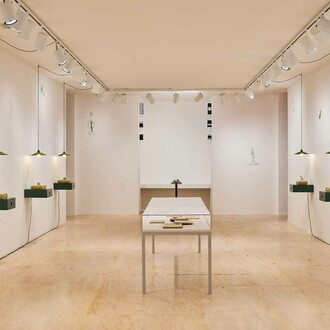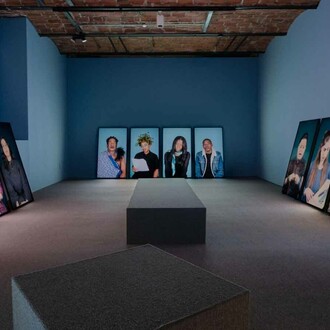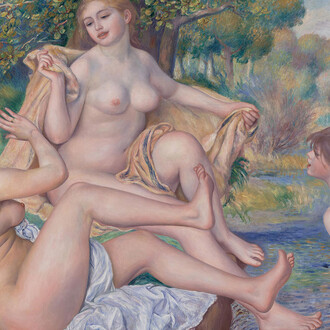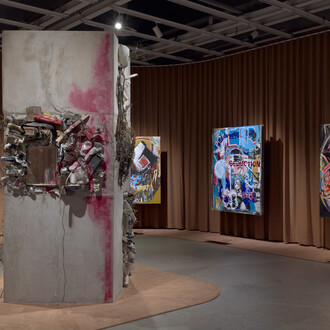Lehmann Maupin, Hong Kong is pleased to announce that renowned international curator Hervé Mikaeloff has organized a dynamic group show featuring a selection of Eastern and Western contemporary artists exploring notions of language. The show, entitled Writings Without Borders, will highlight a wide variety of artistic styles, ranging from painting, drawing, photography, embroidery, and neon, by Tracey Emin, Teresita Fernández, He An, Shirazeh Houshiary, Idris Khan, Barbara Kruger, Eko Nugroho, Pak Sheung Chuen, Robin Rhode, Tsang Kin-wah, and Zheng Guogu. Writings Without Borders will be on view at 407 Pedder Building, 12 Pedder Street, in Central, from 21 May through 20 July 2013.
To write could be defined as the action of transferring a word, a thought, an idea, a story, a dream from an undefined state to the fixity of a graphic sign. Writing can be the expression of a gesture (drawing, painting, dripping…), a way to keep a trace of the past (history and memory), an intimate biographical testimony, or a public announcement. It is also the place of several types of contradictions: civilization of sign and that of the image, mystery and clarity, the indecipherable and the revealed, symbolism and meaning. Writing as language is also a central question in the relationships between different cultures and civilizations, particularly Eastern and Western.
Both in the East and West, artists play with their respective alphabets, words and phrases, using writings, imprints, signs and traces. For some of them, art is simply language. Traditionally in China, there is also an idea of equivalence between art and writing. Drawing and painting belong to Chinese language and writing. During the 20th century, the heritage of calligraphy almost disappeared and finally reemerged as a strong artistic expression more than 25 years ago, whether it is used for formal exploration or for social and political criticism.
In Writings Without Borders, artists from very different countries and origins come together with their own approach to writing and the universal themes that relate to it. In many cultures such as Arabic or Chinese, calligraphy is used as a path to meditation and poetry like in Shirazeh Houshiary’s practice of painting, in which she layers calligraphic script until it effectively dissolves into abstraction. Idris Khan also refers to this tradition with his monochrome works stamped repeatedly with words resulting in almost indecipherable layers, fading like traces in our memory.
In her “Night Writing” series, Teresita Fernández references “Ecriture Nocturne,” an early type of encoded writing similar to Braille invented in the early 19th century to help soldiers to communicate in the dark. Engraving the gallery wall with the word ‘moon,’ Hong Kong artist Pak Sheung Chuen reveals the potential of sign as a visual language to reveal unexpected connections when translated from English to Chinese.
Two other artists from the same region share this conceptual approach to writing: Tsang Kin-wah and Zheng Guogu. Using decorative qualities of calligraphy, Tsang Kin-wah combines the beauty of floral ornamentation with crude words spelling out the physical, sexual, and material obsessions of our contemporary world. This concern is echoed in a painting by Zheng Guogu showing scripts of various logos and advertisements with Hong Kong’s famous Pedder Street in the background. The confrontation of words and images is represented in the work of another major artist, Barbara Kruger, who utilizes both to criticize consumer culture and our fascination for mass media.
From the public to the intimate, Indonesian artist Eko Nugroho has based his snapshot embroideries series on the photographs he takes from the streets of a foreign city or at home in his studio as a documentation of his every day life like a personal dairy. The relation between public and private is also tested by Tracey Emin and He An, both of whom use neon writings as a visual poetry to express their emotions. Another form of poetry from the street is present in the works of South African artist Robin Rhode who brings together body and sign in a choreographic gesture.
Tracey Emin (b. 1963, Croydon, United Kingdom) is internationally recognized for her blunt and revealing style, which elicits a broad range of emotions from shock to empathy to self-reflection. Drawing on personal experiences, Emin often reveals emotional situations with brutal honesty and poetic humor in a wide variety of media including painting, drawing, embroidery, neon, installation, sculpture, and film. In 2007, she was chosen to represent Great Britain at the Venice Biennale. That same year, Emin was made a Royal Academician and was awarded an Honorary Doctorate from the Royal College of Art, a Doctor of Letters from the University of Kent, and a Doctor of Philosophy from London Metropolitan University. In 2013, Queen Elizabeth II appointed Emin a Commander of the Most Excellent Order of the British Empire for her contributions to the visual arts. In recent years, Emin has been the subject of numerous retrospective exhibitions, and her work can be found in many of the world’s most prestigious public collections. The artist currently lives and works in London, England.
Teresita Fernández (b. 1968, Miami, Florida) is best known for her prominent public sculptures and unconventional use of materials. Her work is characterized by an interest in perception and the natural world. Diverse in materials and wide-ranging conceptually, Fernández creates experiential, large-scale works that are often inspired by landscape and place as well as diverse historical and cultural references. In 2011, she was appointed to serve on the U.S. Commission of Fine Arts and is the recipient numerous awards, including a 2005 MacArthur Fellowship, an American Academy in Rome Fellowship, and a National Endowment for Arts Artist's Grant. Fernández’s works are included in many prominent collections and have been exhibited extensively both nationally and internationally. The artist currently lives and works in New York City.
He An (b. 1971, Wuhan, China) graduated from the Hubei Academy of Fine Arts in 1996. He later participated in a three-month residency at the Chinese Arts Center in Manchester, United Kingdom. His work addresses the impact of mainstream Western culture on a new generation of Chinese youth. The artist has participated in solo and group exhibitions abroad and in China, including the 2006 Shanghai Biennale. He An has now added various media to his practice such as sculpture, painting and installation which were presented in group exhibitions, notably The Exhibition of Young Artists, Shanghai Duolun Museum of Modern Art (2004), The Real Thing, Tate Liverpool, (2007) and Rendezvous, MAC-LYON (2008). The artist currently lives and works in Beijing.
Shirazeh Houshiary (born 1955, Shiraz, Iran) is a London-based artist who rose to prominence in the 1980s. She is well known for sculptural works that investigate spiritual principles and abstract forms, including her interest in Sufism and the 13th-century mystical poet, Jalal al-Din Rumi. Her labor-intensive abstract paintings are the result of layers upon layers of script, often times calligraphy, deliberately rendered indecipherable, resulting in a meditative visual experience that is about presence and experience. Houshiary was nominated for the prestigious Turner Prize in 1994 and has exhibited extensively on an international level. She has participated in the 17th Biennale of Sydney, Australia (2010) and the Kiev Biennale, Ukraine (2012), and in June, she will take part in two collateral exhibitions at the 55th Venice Biennale (2013).
Idris Khan (1978, Birmingham, United Kingdom) is a London-based artist best known for his minimal photographs, sculptures, and videos. His works is greatly influenced by cultural sources such as music, art, literature, and religion. Khan experiments heavily with digital photographs, which are a combination of the artist’s personal archive and material sourced from mainstream culture. The result is an unusual combination of abstraction and familiarity. Khan's work is included in many prestigious permanent collections worldwide and has been featured in numerous group exhibitions, including the Saatchi Gallery, London; Tate Britain, London; Hayward Gallery, London; Solomon R. Guggenheim Museum, New York; San Francisco Museum of Modern Art; and Helsinki Kunsthalle.
Barbara Kruger (b. 1945, Newark, New Jersey) is an American conceptual artist best known for her graphic black and white photographs, overlaid with bold red captions such as the popular slogan "I shop therefore I am." Kruger’s thought-provoking works explore questions of identity and gender and challenge or even criticize the ideas surrounding consumerism and contemporary society. Her time as a graphic designer and editor was a major influence on the illustrative and commercial nature of her work. Kruger's art can be seen worldwide in public spaces such as billboards, buses, train stations, and parks; her work has also been featured in solo exhibitions at the Whitney Museum of American Art, New York; Museum of Contemporary Art, Los Angeles; Institute of Contemporary Arts, London, and the Museum of Contemporary Art San Diego. Kruger received the MoCA Award to Distinguished Women in the Arts in 2001 and a Golden Lion for lifetime achievement at the 2005 Venice Biennale. The artist lives and works in New York City.
Both a native and current resident of Indonesia, Eko Nugroho (b. 1977, Yogyakarta, Indonesia) is greatly inspired by his culture and the turbulent Reformasi, a period of economic and political reformation that occurred in Indonesia in the late 1990s. His diverse range represents a quirky mix of Indonesian culture inspired by street art and comics. Whether rendered in black and white or in color, Nugroho's work has a bold and graphic presence with textile-like designs and backgrounds. While he primarily creates drawings and paintings, Nugroho also experiments with other forms of media including video, murals, comics, and embroidery. His has participated in solo exhibitions internationally, and his work is part of numerous prestigious institutions worldwide. The artist is one of five artists selected to represent the first-ever Indonesia pavilion at the 55th Venice Biennale (2013).
Pak Sheung Chuen (aka Tozer Pak) (b. 1977, Fujian, China) graduated from the Department of Fine Arts at the Chinese University of Hong Kong. The artist’s approach to creating a wide range of work, including installations, photographs, paintings, videos, and performances, continues and expands upon the history of conceptual art in both Eastern and Western traditions. Pak Sheung Chuen draws inspiration from the realities of everyday life and through his unique interpretations imbues these potential situations with uncharted possibilities. His work is largely ephemeral and ambiguous. In 2009, Pak Sheung Chuen represented Hong Kong at the 53rd Venice Biennale, and has also participated in the Busan, Liverpool, and Taipei Biennales. He was awarded the Best Artist prize at the 2012 Chinese Contemporary Art Awards. The artist currently lives and works in Hong Kong.
Robin Rhode (b. 1976, Cape Town, South Africa) was raised in Johannesburg and graduated from the South Africa School of Film, Television and Dramatic Arts, Johannesburg, in 2000. The Berlin-based multidisciplinary artist engages a variety of visual languages such as photography, performance, drawing and sculpture to create arrestingly beautiful narratives that are brought to life using quotidian materials such as soap, charcoal, chalk and paint. His strategic interventions transform urban landscapes into imaginary worlds, compressing space and time, as two-dimensional renderings become the subject of three-dimensional interactions by a sole protagonist, usually played by the artist or by an actor inhabiting the role of artist. Rhode's work has been exhibited in museums and galleries around the world. His work is currently the subject of a solo museum show at the National Gallery of Victoria, Melbourne, Australia, through September 15, 2013.
Hong Kong-based artist Tsang Kin-wah (1976, Shantou, China) attended the Chinese University of Hong Kong and Camberwell College of Arts, London Institute. Tsang Kin-wah is best known for his site-specific installations featuring graphic designs and patterns that are actually formed by the decorative interlacing of words or phrase, often times explicit and profane. Some of his works are physically applied like wallpaper, whereas others, such as the 2009 installation at the Hong Kong Museum of Art, are projected, creating a swirling motion of language. The patterns and designs Tsang Kin-wah creates occasionally have a preexisting historical or cultural significance and are, in some instances, instantly recognizable. Tsang Kin-wah has had solo exhibitions at Yvon Lambert Gallery, New York and Paris, and at the Mori Art Museum, Tokyo. His work has been included in group exhibitions at Leeum, Samsung Museum of Art, Seoul; Museum of Contemporary Art Shanghai; and the National Museum of Art, Architecture and Design, Oslo.
Zheng Guogu (b. 1970, Yangjiang, China) studied printmaking at the Guangzhou Academy of Fine Arts. He works across a wide range of disciplines, creating works that respond to the post-Cultural Revolution generation and the rapid social and economic transformations taking place in China. His collaborative nature and conceptual approach was influenced by an artist collective called the Big Tail Elephant Group, which led him to form the Yangjiang Calligraphy Group, a collective that utilizes calligraphy in contemporary and unorthodox ways. Zheng Guogu’s work has been included in exhibitions around the world and at the 50th Venice Biennale in 2003. He was the recipient of the 2006 Chinese Contemporary Art award. Zheng Guogu continues to live and work in Yangjiang.
Lehmann Maupin
12 Pedder Street
Central, Hong Kong
Tel. +852 2530 0025
hongkong@lehmannmaupin.com
www.lehmannmaupin.com
Opening hours
Tuesday - Friday
From 10am until 7pm
Saturday from 11am until 7pm














